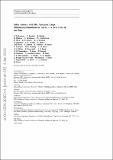Solar science with the Atacama Large Millimeter/Submillimeter Array — a new view of our sun
Abstract
The Atacama Large Millimeter/submillimeter Array (ALMA) is a new powerful tool for observing the Sun at high spatial, temporal, and spectral resolution. These capabilities can address a broad range of fundamental scientific questions in solar physics. The radiation observed by ALMA originates mostly from the chromosphere—a complex and dynamic region between the photosphere and corona, which plays a crucial role in the transport of energy and matter and, ultimately, the heating of the outer layers of the solar atmosphere. Based on first solar test observations, strategies for regular solar campaigns are currently being developed. State-of-the-art numerical simulations of the solar atmosphere and modeling of instrumental effects can help constrain and optimize future observing modes for ALMA. Here we present a short technical description of ALMA and an overview of past efforts and future possibilities for solar observations at submillimeter and millimeter wavelengths. In addition, selected numerical simulations and observations at other wavelengths demonstrate ALMA's scientific potential for studying the Sun for a large range of science cases.
Citation
Wedemeyer , S , Bastian , T , Brajša , R , Hudson , H , Fleishman , G , Loukitcheva , M , Fleck , B , Kontar , E P , De Pontieu , B , Yagoubov , P , Tiwari , S K , Soler , R , Black , J H , Antolin , P , Scullion , E , Gunár , S , Labrosse , N , Ludwig , H-G , Benz , A O , White , S M , Hauschildt , P , Doyle , J G , Nakariakov , V M , Ayres , T , Heinzel , P , Karlicky , M , Van Doorsselaere , T , Gary , D , Alissandrakis , C E , Nindos , A , Solanki , S K , Rouppe van der Voort , L , Shimojo , M , Kato , Y , Zaqarashvili , T , Perez , E , Selhorst , C L & Barta , M 2016 , ' Solar science with the Atacama Large Millimeter/Submillimeter Array — a new view of our sun ' , Space Science Reviews , vol. 200 , no. 1 , pp. 1-73 . https://doi.org/10.1007/s11214-015-0229-9
Publication
Space Science Reviews
Status
Peer reviewed
ISSN
0038-6308Type
Journal article
Collections
Items in the St Andrews Research Repository are protected by copyright, with all rights reserved, unless otherwise indicated.

